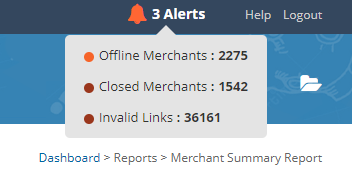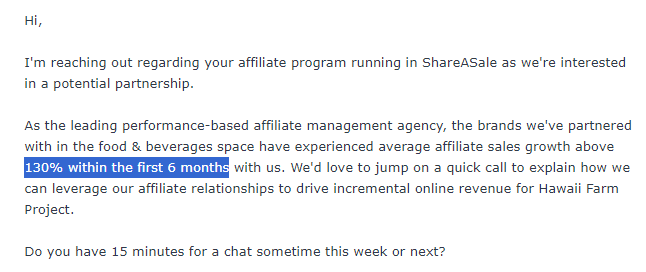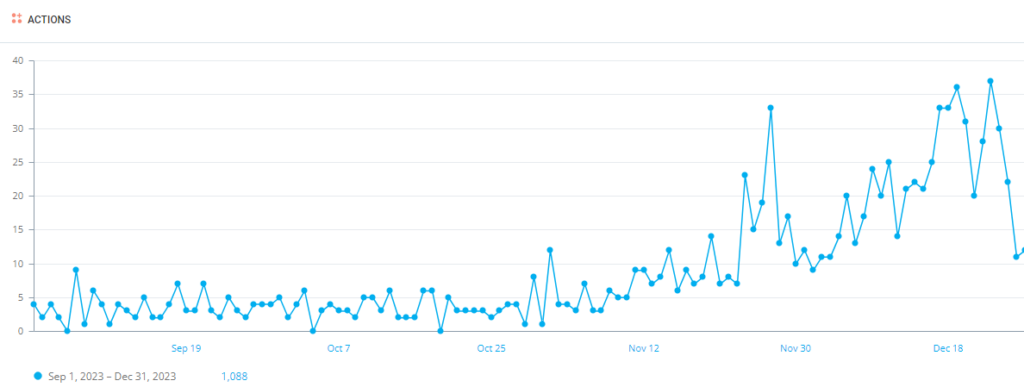Wondering what to expect from affiliate marketing in 2024? It’s understandable after the challenging and bumpy ride we had in 2023. Well, I’m a firm believer that the harder the climb, the greater the satisfaction. I was proven right last year, and I’m sure this year will be the same. I’m not going to quote affiliate marketing stats you see everywhere for 2023 or 2024, no matter how interesting or well-supported. They reflect averages and industry-wide estimates that are difficult to apply to individual businesses and don’t take into account their specifics and the challenges they face(d). Instead, I’d like to give you my overview of 2023.
Brief Overview of 2023
- After the e-commerce boom and after the pandemic, competition tightened. New brands emerged, competing for the same affiliates and increasing marketing costs.
- Shoppers got back to physical stores. Threatened by job loss, price increases, and forecasted financial crises, they became more mindful of how and where they spend their money.
- Content creators became more selective and started charging more for creating content and promoting brands and services to their audience. Disappointed by some brands’ lack of or bad affiliate program management, stock, and tracking issues, many stopped working on a commission and began charging flat fees.
- Affiliate performance shifted greatly as some affiliate websites lost traffic due to Google’s algorithm changes and others changed their management and strategy. Campaigns that once had record ROI stopped performing. Affiliates who used to drive tens or hundreds of sales every month stopped moving the needle (despite no lost placements).
 Companies that used to sell millions monthly sunk or got bought by bigger players. Brands and affiliates switched affiliate networks. New software, tools, and platforms supposed to make affiliate marketing easier, facilitate recruitment and management, and improve performance were launched.
Companies that used to sell millions monthly sunk or got bought by bigger players. Brands and affiliates switched affiliate networks. New software, tools, and platforms supposed to make affiliate marketing easier, facilitate recruitment and management, and improve performance were launched.- Thousands of brands closed their affiliate programs or neglected them to the point where they ran out of funds, went offline, and wasted traffic on broken links. Others started affiliate programs hoping to boost their sales at minimum costs. Some even tried multiple programs and platforms at the same time, approving everyone who showed interest, without realizing how vulnerable to fraud and double dipping they were.
- Many affiliate marketing agencies, unable to keep their clients or desperate to obtain new ones, started going after other agencies’ clients, promising them insignificant growth.

How We Ruled Affiliate Marketing in 2023
At AM Navigator, we consider it part of our job to know our clients’ markets and competitors. We caught changes when they started, and we helped our clients adjust to them and keep up with the competition by:
- Keeping our programs well-funded and live at all times, providing a wide range of creatives, and making sure all links function flawlessly
- Contributing to graphics creation, PR campaigns, company-wide marketing strategies, and website and affiliate conversion optimization where possible
- Policing affiliates, preventing fraud, parasitism, and activities that don’t add value, and monitoring and protecting brand reputation
- Monitoring affiliate performance closely across various affiliate programs and optimizing where we could
- Nurturing existing partnerships and communicating closely with affiliates, motivating them to activate and scale
- Intensifying recruitment, building new partnerships, and identifying new growth and optimization opportunities
- Working closely with our clients’ in-house teams to optimize strategies and increase brand awareness and sales
- Monitoring costs and ensuring we stay within budget and obtain the desired ROI
- Testing new tools and providers to improve our arsenal and streamline and increase our efforts
- Continuing to learn and improve, to build on the already strong foundations we laid
It’s actually difficult to summarize everything we did because we use a different strategy for every client, customized to their business specifics, needs, and goals. What matters is that our strategies worked and affiliates drove between 25% and 50% of our clients’ online sales. Our results allowed us to keep our clients (and some of them have been with us for close to a decade) and grow their affiliate programs despite the challenges.


Affiliate Marketing in 2024: Trends and Tips to Succeed
1. The Most Popular, More Reliable, and Highest Paying Brands Rule
Affiliates invest thought, time, and effort in every post and every campaign, with the same goals as merchants: to sell and earn as much as possible. Popular brands are easy to promote. They already have a huge pool of existing and, in many cases, loyal customers affiliates may touch, aggressive marketing campaigns for affiliates to leverage, high existing interest for their brand and products, and larger budgets.
Smaller and new brands are more difficult to promote due to their lack of brand awareness, low number of reviews, and, usually, limited to no budget for PR campaigns and VIP commissions. Worse, and 2023 showed it extensively, some small brands are unreliable, unable to maintain stock, ensure proper affiliate program funding and management, etc. Many leave the market the way they came in, quietly and without making a difference.
This doesn’t mean that small brands can’t succeed. The two clients given as examples above are rather small brands with low brand awareness and limited to no budgets. To be successful, small brands require an attractive offer to buyers and affiliates, a wide and stable inventory, and a well-connected and equipped partner to represent them and protect their interests. But, perhaps the most important assets are patience, consistency, and a long-term strategy.
Affiliates often take weeks, even months to create in-depth reviews. One or two reviews may not be enough to drive sales but they are a start and they can be used to obtain even more reviews and opportunities. When you start an affiliate program or partner with an affiliate management agency, allow for at least 3 or 6 months before making any drastic decisions. Besides sales and traffic, also pay attention to the number of placements, active partners, and, why not, results outside the affiliate program.
2. Merchants Test New Solutions
Many merchants mistakenly believe that their success will depend on the network, software, or influencer platform they use. Many start an affiliate program, and when it doesn’t grow by itself or they get approached by another network or provider promising the moon and the sky, they switch platforms or solutions. I expect this trend to intensify in 2024, with more brands launching affiliate programs without or with poor management.
It’s important to start the program on a popular platform, with advanced tracking and attribution solutions, suitable for influencers as well. But it’s essential to understand that the platform alone won’t do the work for you, and switching without solid reason and close management to secure the transition is never a good idea. Having tested more than 20 software solutions and platforms this year, I can tell you that none of them is perfect or infallible. Generally, if you’re on one of the major affiliate networks, like ShareASale, Impact, Rakuten, or CJ, you don’t need to switch.
Tips to Improve Performance Without Switching Networks or Software
- Use additional tools for recruitment and outreach – affiliate networks’ recruitment tools alone will never be enough
- Test and monitor tracking and work with the network to improve it if needed or manually pay commissions on sales that didn’t track
- Look into setting up an express signup page that would make it easier for new partners to join
- Put together easy-to-follow instructions to ease the signup and activation process for new partners who aren’t already using the platform
If you do decide to make a change and already have valuable partners joined, it’s vital to notify them and help them benefit from the new solution. It’s your job to ensure a smooth transition with no downtime or broken links, and no payment delays. Partners left behind will think twice before working with you again, perceiving you as an unreliable partner. The old platform most likely made you sign a contract that prohibits moving affiliates to another network, making the switch even more challenging.
And if you mistakenly believe that starting multiple affiliate programs will bring you more traffic and sales, think again! Buyer journeys are rarely streamlined. People look up reviews, compare prices, look for discount codes, and use cashback apps. By the time they place their order, chances are several affiliates have touched them. And since there’s no way to deduplicate sales and commissions between platforms, chances are you’ll pay multiple commissions on the same sales. Voiding commission in one affiliate program will surely upset the affiliates affected and discourage them from promoting you. It will also negatively affect your affiliate program statistics. Success in affiliate marketing in 2024 will certainly not come from multiple affiliate programs but from the smart and close management of one program.
3. More Low-Quality Affiliates and Higher Risk of Fraud
It started in 2023, and I expect it to get worse in 2024: an avalanche of fake and low-quality affiliate applications, taking different forms on different networks, depending on their specifics.
Possible Red Flags for Low-Quality Affiliates
- Accounts listing websites or social media accounts they don’t own (check the About section, look at names and countries of origin)
- Promotional methods focused on media buying, paid ads, or discounts
- Application messages that don’t make sense or promise the moon and the sky (affiliate marketer with x years of experience, sales of millions of dollars, etc.)
- Stats that don’t match the listed website (huge audience for websites with no or very low traffic)
- Negative feedback from other merchants
- Limited or unverified accounts and spammy associated email addresses, etc.
In the affiliate programs I manage, I reject over 70% of the affiliate applications I receive, after carefully reviewing each of them, of course. If you unknowingly accept bad affiliates, monitoring sales and traffic daily should help you identify bad apples and remove them. It’s vital to have anti-fraud solutions in place for your e-commerce store and not fulfill suspicious orders without verifying buyer identity. This way, you avoid losing products on fraudulent orders and then having to refund their value.
Red Flags for Fraud Orders
- Multiple refund requests for orders referred by a specific affiliate
- High amounts of traffic from low-audience websites
- Several orders with the same IP
- Unusually high conversion rates
- Affiliates referring traffic for which the source can’t be identified
- Major reporting discrepancies between the affiliate program and the e-commerce platform
- High rate of sales overwritten from other affiliates
The bottom line is that sales don’t fall from the sky and what seems too good to be true usually is. You have to manage your affiliate program closely and investigate the source of all traffic and sales. This will allow you to protect your business, remove bad affiliates, and grow worthwhile partnerships.
4. New Types of Affiliates Emerge and Rule
Review, content, and comparison affiliates, as well as influencers, are vital for any affiliate program. But, as mentioned above, they’re very selective and take time to create content. While you convince them and wait for them, look into new types of partnerships as well. Some categories with the potential to become top performers in 2024 affiliate marketing are:
- Audience monetization tools
- Card-linking loyalty companies
- Shopping assistant apps
- Member benefits platforms
- Look-a-like audience builders
- Big-media shopping sections
- Programmatic ads experts and platforms
We all love and want more content creators in our affiliate programs. But it’s worth reaching out to prospects in the above categories and more as well. Anyone with the right audience could become a valuable partner if they present your offer in the right context. Diversification will be key in affiliate marketing in 2024.
5. AI Involvement Increases
Chat GPT and the following tools and platforms made it clear that artificial intelligence is here to stay. Its impact on affiliate marketing will surely increase even more this year. However, not everything AI-derived is good. I’ve seen a ton of poor-quality websites with AI-created content, so I can only hope the search engines, the merchants, and the buyers will begin to be more selective and appreciate the human factor more, especially in content creation. AI is the future but, until it learns to read minds, just like most tools and equipment, it will depend on the user, the commands, and the quality standards.
6. Better Affiliate Support
Many merchants still believe that all they need to be successful is to set up an affiliate program, add a few banners, and maybe tell affiliates which products to promote. It doesn’t work like that. Not only that affiliates choose which products to promote, where, and how, but they also choose which merchants to work with. You can be sure that they won’t bother to promote a brand from which they don’t receive competitive commissions, timely responses, stock notifications, and excellent support.
If you want to succeed, stop trying to impose things on your affiliates. Don’t try to trick them into promoting you for low commissions when you can afford more. Be an honest and reliable partner, help them sell and earn, provide everything you’d want to receive if you were in their shoes, warn them of stock issues, and make sure tracking works well or compensate manually when it doesn’t. If they’re happy, they’ll expand their promotions and drive even more traffic and sales to you, so you’ll be happy as well.
7. More Unified Marketing Strategy
Before competition tightened and affiliate expectations grew, many brands segmented their audiences and marketing efforts, letting different teams adopt different strategies. Now audiences overlap, and the same shoppers are exposed to several if not all marketing channels. They’re basically harassed by ads and content everywhere they look, so it’s important to streamline their journey to checkout with coherent and cohesive marketing messages.
Tips to Streamline Your Marketing Strategy and Buyer Journey
 Make your different teams work together, build common strategies, and use compatible marketing messages
Make your different teams work together, build common strategies, and use compatible marketing messages- Always advertise your highest discounts and best-selling points
- Build your campaigns around major holidays and best-stocked products
- Take channel overlaps into account when establishing budgets and commissions
- Force communication across teams and channels
Let’s say your PR team or influencer marketing team secures some great placements. Those publishers will most likely monetize their content through affiliate links. If aware of the placements and part of the conversations, your affiliate manager can convince them to scale and continue to promote your brand long after the preliminary campaign is over. Shoppers exposed to that content may also look up affiliate reviews, click paid or social media ads, look for coupons, or use cashback apps. Those buyers will then be retargeted by your email marketing team, prompted to leave reviews and buy again. The reviews and placements can be shared and bragged with on social media, to further increase brand awareness and boost your reputation.
The resulting sales cannot be attributed to a single channel because they’re the result of all interactions. So your marketing channels and the teams managing them should work together and all get some credit for their role in the buyer journey. At AM Navigator, we always preach unified marketing strategies. Some clients follow through, others don’t, but the results are always better for those who do. We expect this trend to increase and become the norm in 2024, especially since disruptions and inconsistencies in the buyer journey negatively impact sales and brand image.
8. Increased Physical Presence
In a market stuffed with one-man-show brands built overnight and that disappear just as fast, affiliates have grown to appreciate physical presence, brands that also sell in physical stores or have showrooms, and whose representatives attend industry events. Whether it’s an affiliate marketing conference, an event dedicated to a specific affiliate segment, or some other event dedicated to your specific products and services, consider participating or working with an agency that can represent you.
Geno’s AM Days workshop within the Affiliate Summit and our team’s participation at affiliate marketing conferences worldwide have always benefitted our clients. We keep opening doors that otherwise remained shut and consolidate partnerships to a degree that online meetings and discussions alone couldn’t. At the same time, our clients’ physical presence in local markets or industry events always benefits the affiliate program and their company as a whole. So find out what events and opportunities are available, and do your best to take advantage. People will still shop and can still be reached online, but any type of physical presence makes your brand more tangible, more accessible, more powerful, and more reliable.
9. More Brands Expanding Internationally
Companies successful in one country will find it easier than ever to expand internationally. There are more and more 3rd party providers able to cover the logistics, and international shipping is becoming faster and more affordable. AI has made it easier than ever to replicate websites and translate content. What’s even better, affiliates love international brands, especially when their affiliate programs are set up in an affiliate-friendly way.
It may seem easier to build and manage separate stores and affiliate programs but don’t! You’ll only be segmenting your chances to succeed and increasing your costs. At AM Navigator, we’ve had the privilege to set up and grow quite a few international affiliate programs and experience the benefits first-hand. You’d be surprised how many U.S. affiliates influence Canadian, Central and Latin America, Australia, and even UK shoppers. All you need to do is create an affiliate program that enables affiliates to reach their full potential and drive sales to several stores/countries.
Choose platforms that allow several stores under the same affiliate program and enable affiliates to get rewarded when/if the shopper they refer to one store/country ends up buying from the other ones as well. All those affiliates and big media publishers who now look down on you and refuse to promote your brand will likely be intrigued by the perspective of working with an international brand and they’ll give you a chance.
10. Varying Results and Performances
When investing in a new campaign or partnership, most merchants want to know what they’ll get in return. They’re looking especially for traffic and sales estimates, but those will be harder than ever to obtain and/or match. People respond differently to different content, different products, and different brands. Similar campaigns can drive record traffic and sales to one brand and much lower results to another one. Websites and social media accounts that publish viral content today may see huge traffic and engagement drops tomorrow.
Therefore, when planning your budget and campaigns, don’t rely solely on estimates. Evaluate each partner carefully to know exactly what you’re looking at. Make sure they target your desired audience and that their content matches your brand and goals. Look not only at their media kit but also at each account, overall audience, and engagement (views, likes, comments, click-through rates, etc.). Once you’ve decided to move forward with a campaign or partnership, do everything you can to make the most of the traffic generated. For example:
- Make sure the focus product is well-stocked, choose the best-converting landing page (or create a co-branded page), and upsell
- Provide your partner with an exclusive coupon or a vanity code to share with their audience and improve engagement and conversion
- Retarget referred visitors by emails, SMS, and display ads
- Try to turn first-time buyers into loyal customers with exclusive offers and rewards
- Turn buyers into brand ambassadors by incentivizing them to create reviews, share your brand on social media, and recommend your products to contacts.
Final Thoughts on Affiliate Marketing in 2024

This is the year of the strong and the witty, the rich and the cute, the bold and the persistent. Our advice is that you gear up, focus on what you can control and improve, like products, stock, website, conversion, customer service, etc., and empower marketing experts and affiliates to do what they do best: build brand awareness, drive traffic, and help you sell. Be the best partner you can be for the most valuable affiliates, stay informed, keep up with change, and think outside the box! It will be a little more difficult to be successful in affiliate marketing in 2024 but certainly not impossible, especially for those who work hard, know what they’re doing, and don’t give up at the first obstacle.
Would you like to add anything to the above? Please share your thoughts in a comment below! Are you curious how the above trends and tips can help your specific business and need help getting started or improving your affiliate marketing in 2024? Get in touch!